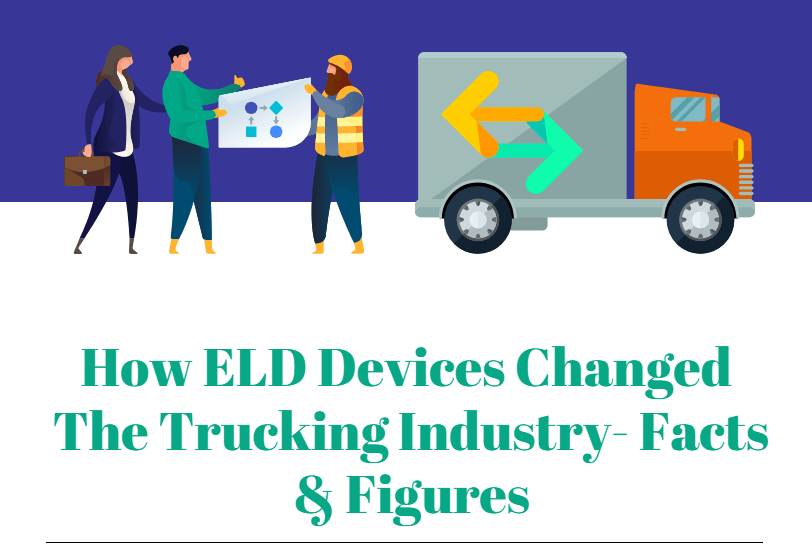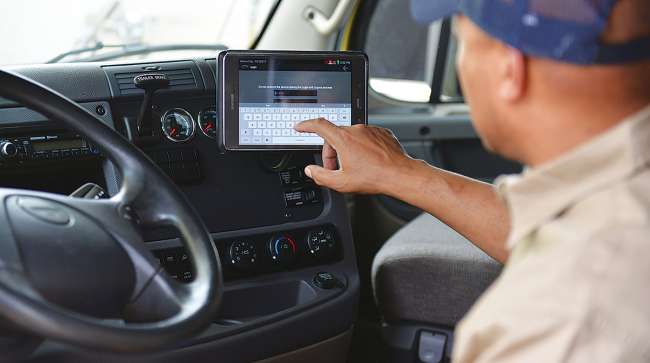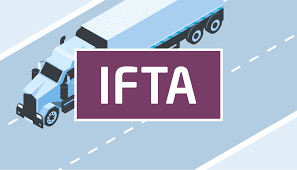How ELD Devices Changed The Trucking Industry- Facts & Figures
Electronic logging devices (ELDs) devices are playing an important role in transforming the trucking industry. These devices have become more important in the transportation sector in recent years. These gadgets, which track and record a driver’s hours of service and other crucial information, have become an essential aspect of the industry’s operations.
Table of Contents
The Federal Motor Carrier Safety Administration (FMCSA) issued the ELD requirement in 2015, mandating all relevant carriers to adopt ELD systems. ELDs provide considerable benefits to the transportation sector and have become an essential component of its laws.
Read on to learn more about ELDs and how they are changing the trucking industry.
What exactly are ELDs?
ELDs (Electronic Logging Devices) demonstrate if the trucking firm and its drivers comply with trucking industry standards. The gadget also allows drivers to record their driving time and miles. As a result, ELD systems contribute to a safer working environment for truckers by assisting employers with vehicle inspections and allowing them to satisfy industry standards.
What Data Does an ELD Record?
ELDs are primarily used to record Hours of Service (HOS)—the number of hours a commercial driver drives each day, as well as how many hours they are on-duty and off-duty every week. The federal government regulates HOS, and many business fleets are obliged to have an ELD system for this purpose.
ELDs, on the other hand, can be used to record a range of additional data useful for fleet management. This is why ELD devices are also known as “telematics” devices; “telematics” refers to the long-distance transfer of any digital information.
The greatest ELDs, which include GPS tracking, gyroscopes, and accelerometers, can record:
- Real-time GPS locations
- Engine load and speed
- Safety-related events
- Drive time, HOS, and record of duty status
- Faulty codes and diagnostics
What Is the ELD Mandate?
Since 1938, HOS laws have limited driver activity, and the ELD mandate maintains current standards. According to the Federal Motor Carrier Safety Administration (FMCSA), “the electronic logging device (ELD) rule, which Congress mandated as part of MAP-21, is intended to help create a safer work environment for drivers, as well as make it easier and faster to track, manage, and share records of duty status (RODS) data.” An ELD synchronizes with a vehicle engine to automatically record driving time, making hours of service (HOS) tracking simpler and more accurate.”
The major key points of the rule include:
- Commercial drivers who are obliged to prepare hours-of-service (HOS) records of duty status (RODS) must utilize an ELD.
- Determines the supporting documents drivers and carriers must retain.
- Harassment of drivers based on ELD data or related technology (such as a fleet management system) is prohibited. The rule also gives drivers who think they have been harassed redress.
- ELD performance and design criteria are established, and ELDs must be approved and registered with FMCSA.
Who is Impacted by the ELD Devices Mandate?
The ELD mandate affects the majority of commercial vehicle drivers. Aside from particular exemptions, this encompasses interstate commerce vehicles that fulfill any of the following descriptions:
- Vehicles that weigh 10001 pounds or even more.
- The vehicle is used to transport 16 or more passengers not for compensation.
- The vehicle is used to transport hazardous materials in a quantity requiring placards.
- Vehicles used to transport 9 or more passengers for compensation.
What Is the Case of ELD in the Current Period?
Today, three years into the ELD requirement, it appears that the more severe forecasts were not realized. Although there may have been some driver or trucking company attrition, transportation demand and the willingness to satisfy it have remained robust, and enterprises have remained successful despite new hurdles. Nonetheless, the logging requirement has had considerable influence on the transportation business.
However, the ELD requirement has given certain benefits to trucking firms in addition to greater safety. Before the requirement, for example, drivers frequently believed that shippers and receivers had a high degree of influence over their timetable. Businesses would regularly make them wait for hours in jail to load or unload their semi-trailer.
Carriers would, unsurprisingly, bill them for that period, but detailed cost analysis revealed that this fee rarely covered their lost earnings. With the ELD regulation putting some pressure on them, truckers may now say, “I just can’t wait four hours for you to load my rig.” In other words, it has provided them with leverage that they did not previously possess.
What Are the Major Impacts of ELD on the Trucking Industry?
ELD devices have brought several changes in the trucking industry. Listed below are some of the impacts that ELDs had on this industry. You can also check out this list of best ELD devices for trucks curated by experts in the domain.
-
Safety is significantly improved
When making deliveries, commercial drivers are generally stressed and fatigued, and they frequently fail to meet transportation rules and maintenance standards. Thanks to the ELD mandate, Investing in ELD technology can enhance driver safety dramatically. ELDs are configured to notify truck drivers of potential maintenance issues or Hours of Service (HOS) compliance issues.
The ELD logs driving time and sends it to an internet server where trucking business administrators may examine the information. This enables trucking businesses to guarantee that their drivers get enough rest between trips and to track their overall performance. These systems also monitor poor driving habits, which can increase the likelihood of a car collision. Such data can help transportation businesses improve their training programs.
Before the inception and implementation of the ELD system, truck drivers had to manually record their hours of duty. It not only took up a lot of their time, but it also added to tension and exhaustion. All of this has altered when ELD systems became mandated for the majority of trucking operations.
-
Operational changes for ELD devices
Another effect of the ELD mandate on transportation operations is a shift to time-based driver remuneration. While mileage has historically been used to calculate pay, time is gradually becoming a more important component.
Trucking businesses are increasingly employing time-based measures to develop new compensation models. This is happening because ELDs provide decision-makers with more visibility into how time is spent during the 14-hour duty cycle, whether it is utilized wisely or wastefully, and how this should affect remuneration.
-
Trucking routes are optimized
Before the ELD mandate, it took a long time for drivers to complete on-time deliveries because of misunderstandings between several parties, such as the dispatcher and the driver. As a result, the trucking firm and its clients suffered financial losses.
Fleet managers can use ELD systems to track locations and change routes to improve operations. It also offers traffic updates to drivers, allowing them to discover the quickest routes to make deliveries while avoiding regions with hazardous weather or heavy traffic.
ELDs also offer information on the fuel economy of the truck. By using ELD technology, truckers may improve their trucking routes and employ speedier routes to their destinations. This can assist lower total fuel use and save money on fuel bills for the trucking firm.
-
The IFTA calculation process is simplified
IFTAs are International Fuel Tax Agreement reports that truckers with IFTA licenses must submit quarterly. Because ELDs can automatically measure fuel consumption, drive time, and miles of the trucks, sending these reports has been simplified. It may also create mileage records for each state. This saves truckers time by eliminating the need to manually calculate kilometers traveled and provide appropriate IFTA reports.
FAQs
Is a smartphone counted as an ELD?
Yes. If it fits the FMCSA’s technological criteria, an ELD can be on a smartphone or similar portable, wireless device. Portable ELDs, including smartphones, must be installed in a permanent position that is visible to the driver at all times while the vehicle is in operation.
Are there any exemptions from the ELD devices mandate?
Yes, there are some exceptions. Drivers who exclusively facilitate intrastate trade, some short-haul trucking, certain agricultural-related trucking, and drivers of vehicles made before the model year 2000 are all on the list. Nonetheless, the ELD rule is intended to apply to the majority of commercial vehicles.
Is real-time tracking of commercial motor vehicles with ELDs required by the ELD rule?
The ELD regulation does not mandate real-time tracking of CMVs. A motor carrier, on the other hand, may utilize technology to track its CMVs in real-time for commercial objectives. A motor carrier may utilize this data as long as it does not annoy other drivers or violate the Federal Motor Carrier Safety Regulations (FMCSRs). To preserve driver privacy, ELDs must limit location information when sharing data with safety officials.

David Rigamon is a consultant in the life sciences and digital marketing space as an Agile Coach. Previously in financial services as a consultant for systems implementations. He is working for Harwood Agile Consultancy.












